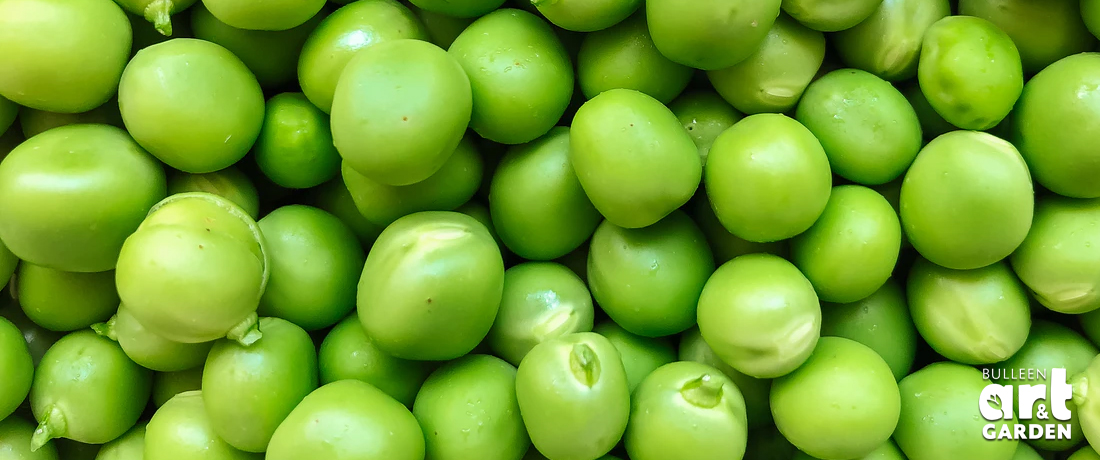
 Important note about plant availability. Important note about plant availability.There are hundreds of factsheets on our website provided for your information. Not all plants will be available at all times throughout the year. To confirm availability please call (03) 8850 3030 and ask for the nursery. |
Peas (Pisum sativum) are cool season legumes grown for their pods and seeds, they’re part of the Fabaceae family, along with other legumes such as beans, chickpeas, and lentils. Like the other members of this family, peas are nitrogen-fixing plants, with nodules along their roots in which symbiotic soil bacteria live. These bacteria convert nitrogen from the air into a form that plants can use as a nutrient.
Edible Pea Types
There are three strains of edible peas grown in Australia:
Garden Peas (Pisum sativum) – also known as green peas, these are slightly sweeter than snow peas but need to be shelled as the pods are tough and inedible.
Snow Peas (Pisum sativum var. macrocarpon) – these produce flat, wide edible pods that are sweet in flavour and have a crunchy texture.
Sugar Snap Peas (Pisum sativum var. saccharatum) – also known as snap peas, these are a cross between garden peas and snow peas. Just like snow peas, their pods are edible, sweet in flavour with a crunchy texture, but the edible pods are rounded in shape rather than flat.
Peas taste best when harvested fairly young. If left too long to mature, edible pea pods may need to be de-stringed by removing the stringy fibres from the top seam of the pod. Snap off the stem end of the pea toward the top seam and pull away the attached stringy part to remove it.
Determinate and Indeterminate Plants
There are two types of pea plants, the shorter bush or dwarf types whose growth habit is described as determinate, and the taller climbing indeterminate types.
Bush peas, also known as dwarf peas, are fairly low growing, as low as 30-40cm high, but many can grow up to 70- 100cm, and therefore may need staking or some other form of support. They’re ideal for growing in pots and containers.
Climbing pea varieties can grow up to 2m in height, and will need a support such as a tee-pee or trellis to grow over. Several pea plants can be grown over a single support structure, so this form of vertical gardening can be very productive, while taking up little space in the garden.
Growing Peas
Peas are planted in the cooler seasons, sow pea seeds from April to September, and they can be harvested in around 9-11 weeks. As a general rule, seedlings are 4-6 weeks ahead of seeds, so it should be possible to plants pea seedlings from May to October.
Since peas like slightly alkaline soil, it’s best to prepare the soil a few weeks before sowing seeds or planting seedlings by adding a small amount of dolomite or garden lime to the soil, along with some manure or a balanced fertiliser. Mix in some compost to improve drainage if the soil is compacted, as peas don’t like ‘wet feet’, better known as waterlogged roots.
Sow pea seeds at a depth approximately three times the diameter of the seed. They’re best sown directly into the soil, when soil temperatures are between 8°C and 24°C. Once planted and watered in, it’s best to avoid watering the seeds as they tend to rot easily from overwatering.
When plants start growing, they will need watering. As peas are susceptible to powdery mildew, it is best to water them early in the day and to water the soil near their roots, without wetting their leaves.
Once the pea plants start producing, pick the pods every day to increase production.
Good companion plants for peas are potatoes, radishes, carrots and turnips. Members of the onion family, such as shallots, onions and garlic are bad companions, as their roots exude antibiotic compounds into the soil which inhibit the nitrogen-fixing bacteria associated with the roots of leguminous plants.
A few popular pea varieties…
Bikini (Snowpea Bush)
A vigorous variety that requires no support. Producing sweet, flat, crispy, 10 cm long pods. Height to 90 cm. Harvest in 70 – 84 days.
Greenfeast (Bush)
Compact bush. Very popular, sweet flavour. A heavy cropper. Fusarium wilt resistant variety.
Honeypod (Sugarsnap Climbing)
A dwarf variety of the climbing pea that produces crisp, edible pods. Pick regularly to extend harvest. Height 45cm x Width 15cm. Use in soups, casseroles, sides, fresh in salads or garden snacks. Even dwarf peas benefit from some support to climb on, a tepee of twigs for example.
Mammoth Melting (Snowpea Climbing)
Sweet, large, flat pods. A high yielding variety. Fusarium wilt resistant variety.
Massey Gem (Bush)
Massey Gem (syn. Melbourne Market) is a popular variety, and is a fast maturing early producing bush shelling pea. Grows to 75 cm, is hardy, cold tolerant and disease resistant. One of the great peas for freezing and shelling. Sweet flavour. It is a very reliable producer.
Oregon Sugarpod (Snowpea Bush)
Large, thick pods. Superbly tender and delicious. Highly productive.
Sugar Ann (Sugarsnap Bush)
An early, edible-pod pea ideal for small gardens. Its short, bushy vines do not need support. Produces about 10 days earlier than other snap peas. Delicious round, fleshy, pale green, sweet tasting pods are a joy sauteed, fresh or steamed. Eat stringless when young, or leave to mature and sweeten.
